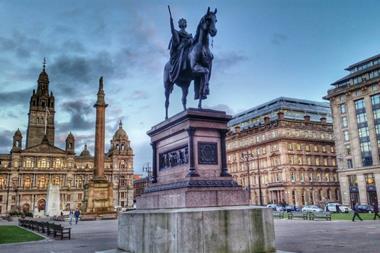Aberdeen is the UK’s forgotten boom town and investors – sick of being outpriced in London – are discovering opportunities in the oil-rich granite city
AB15 is not your typical millionaire’s postcode. Aberdeen’s granite, grey skies, and gravel drives are a long way from London’s glittering West End.
The city centre is hardly a top retail destination, either. Union Street, the main strip, is more Primark than Prada. And at Friday lunchtime, when Mayfair throngs with well-heeled Russians and overseas bling, the Aberdonian oil-rich scuttle to the pub in a fleece and hiking shoes.
Yet this hard surface masks a remarkable truth: the granite city is Britain’s forgotten boom town. The energy-related businesses established there since BP discovered North Sea oil 50 years ago have helped insulate it from the chill winds of the recent recession. In northern Europe’s “Arc of Prosperity”, now dubbed the Arc of Insolvency,
it is the lone survivor.
Aberdeen’s wealth is discreet, but the facts speak for themselves. Aberdeen City and Shire has the 13th-highest GDP per capita of the 271 regions in the European Union. The energy sector accounts for 100,000 jobs. It is among the UK’s most prosperous economies with a 1.7% unemployment rate and its commercial heliport is the world’s busiest. And Rubislaw Den, the city’s Knightsbridge, consistently makes the top five UK postcodes by proportion of millionaires. The one outward symbol of this wealth is the cars. Among BMWs, Porsches and gleaming 4x4s, TVRs are a familiar sight.
Underlying all this, demand for Aberdeen property is stronger than ever, and transactions carried out in 2011 have put this small regional city on investors’ maps. Dealflow was uninterrupted when chancellor George Osborne unveiled a £2bn tax on North Sea oil in March’s Budget.
Two weeks ago, BP, whose headquarters are at Dyce, reaffirmed its faith in North Sea oil by announcing £3bn plans to redevelop fields to the west of the Shetlands.
Property is equally unperturbed. Earlier this month, German fund Aerium bought its first Scottish asset – Hazeldene’s new £50 office development, which broke the record for the highest rent outside London in May.
And despite the drab outward appearance of Union Street, retail is booming. Hammerson’s £275m Union Square shopping centre – Scotland’s second largest – was one of the few retail schemes to open in the regional doldrums of 2009. Hollister, Marks & Spencer and Apple are tenants.
Helen Gordon, director of Legal & General’s Life Fund, sold the scheme to Hammerson on behalf Railtrack in 2002, and says Aberdeen’s property demographics are particularly strong.
“There are certain characteristics that you look for when investing in retail and Aberdeen has them: low reliance on public sector workers, a diverse economy and affordable rents. The three big REITs [British Land, Land Securities, and Hammerson] have holdings there, so that tells a story.”
The picture for offices is no less disappointing. Research published this week by Knight Frank suggests oil- and gas-related companies are searching for a huge 325,000 sq ft of top-grade office space. Offshore drilling giant Transocean and Canadian oil and gas firm Nexen want headquarter buildings of 100,000 sq ft each.
Yet there is only 20,000 sq ft of vacant space available and no development. Hazeldene’s brand-new IQ building was snapped up before completion and broke regional rent records when Centrica paid £31/sq ft to lease the top three floors in May. Meanwhile, five or six prospective occupiers are lining up for every industrial leasing deal.
Now that Aberdeen City Council has finished refurbishing its new headquarters, there is only one crane left, at Aberdeen Royal Infirmary.
UK property has been slow to sniff out the opportunities that such high demand and short supply present. During the past four years of recession, economies outside London have been tarred by the same brush. To investors unwilling to venture as far north as Birmingham, buying in the Grampians is out of the question.
The impact is at its starkest in banking, say local surveyors and developers, because of banks holding on to one-size-fits-all lending criteria that fail to acknowledge the city’s strength.
Graeme Nisbet, formerly business development manager in the Royal Bank of Scotland’s property finance team, and now at Space Solutions, says
only “bona fide” developers will obtain debt.
“The banks can’t cherry-pick certain geographical areas, which is annoying because there is no grade A space in Aberdeen. It is a counter-cyclical market.”
Steve Rae, senior manager for corporate real estate in the north of Scotland at Lloyds Bank corporate markets, believes this is unfair.
“I’m not aware that there are different lending criteria here than in London. The criteria are the same throughout the country. Everything is looked at on an ad hoc basis, but the Aberdeen story helps.”
For Rae, the key difference between Aberdeen and London is the amount of equity available for deals from overseas investors and sovereign wealth funds that understand the capital’s robustness.
Only recently have serious contenders, sick of being outpriced on London deals, started seeking opportunities further north. Aerium, Rockspring, Prupim and CB Richard Ellis have all completed Aberdeen investment deals in the past year, but development is harder to fund.
Malcolm Deans, managing director at Stewart Milne, the city’s biggest developer, says a “significant prelet” is needed: “There are observers saying there should be more finance available, but I’m not aware of lenders willing to do speculative deals.”
This is not the only issue holding back Aberdeen’s property industry. For many potential investors, headquartered in London or overseas, it is just too far away. And at the end of the long journey, which is more than seven hours from London by train, it is not the most inviting of locations.
“It is the one bright spot outside London, but people have been reluctant to take the trip up there,” says Deans. “There’s a much more positive outlook in general, but it’s not a party town.”
Investors are also scathing about Aberdeen’s dependence on North Sea oil, which experts suggest will only last for another 30 or 40 years.
Mark Shaw, chief executive of Hazeldene, and himself an Aberdonian, says this is among several perceived turn-offs: “A lot of the time Aberdeen gets overlooked. It is countercyclical, but people think it is too far north to invest in. Everyone says the oil is going to run out as well.”
Estimates suggest 80% of the city’s property demand is driven by oil and gas, but the local business community is almost obsessed with talking down this one-trick-pony status.
Gordon supports this. She says the days when the economy relied on riggers coming ashore to blow their money are over: “In the 1980s, Aberdeen was highly dependent on oil workers, but in the 1990s it moved much more into research and development around excavation. It’s a completely different economy now.”
On signage everywhere, the council calls Aberdeen the “oil capital of Europe”, but local property people prefer to sell it as a centre of excellence for global energy.
David Mitchell, chief executive of Manse, bought an 83 acre site on the edge of Aberdeen in January, to be developed into 800 homes by Stewart Milne. He sees demand surviving beyond North Sea oil.
“Fundamentally, you have an educated workforce, low unemployment and limited land supply. All that makes for tenant demand. It is a centre of excellence for exploration businesses worldwide, and has a workforce that has been working on oil for 40 years. The oil and gas help, but renewable energy is getting bigger.”
Two years ago, the Scottish government launched Energetica, a drive to diversify the area into other forms of energy, such as renewables. But the fact is that demand tracks the ebb and flow of global oil prices remarkably closely. If oil slides, so does the local economy.
In the good times, however, the power in Aberdeen’s property market is in the hands of a few and local developers want to keep it that way. One surveyor says: “The market used to be like a cartel. Local developers would get together in the pub and decide between them when each scheme would start, so as not to saturate the market.”
Aberdeen’s property market has, until recently, been as closed and unglamorous as the city itself. One local developer says: “People think you just need to walk into the city and deals fall off the shelf. They think Aberdeen is paved with gold.”
Deans, meanwhile, is awaiting a planning decision on Stewart Milne’s 72,000 sq ft office scheme called Triple Kirks. If it receives consent, it will be the next city centre office development that comes out of the ground, and he is bullish about its prospects.
“I kicked off the scheme three years ago, and I’m more positive about the site than I ever have been. There has never been a better time to do it.
“I’m fully expecting to have the kind of prelet in the next 12 months that the boys in Glasgow or Edinburgh can only dream about.”
Aberdeen might be perceived to be more about granite than black gold, but there are treasures there for investors willing to make the trip.





























No comments yet